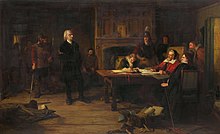John Rae (minister)
John Rae | |
|---|---|
| Personal details | |
| Denomination | Christian |
John Rae was the son of William Rae, burgess of Edinburgh.[1] He served heir 7 February 1666. He was educated at the University of Glasgow and graduated with an M.A. in 1651.[2]
At the Restoration he was minister of Symington in the Presbytery of Biggar being admitted between 4 May and 2 November 1658. He was deprived by the Act of Parliament 11th June, and of Privy Council 1 October 1662. He became one of the most zealous of the Covenanting preachers; and for eight years peregrinated the country, conducting public worship on the hillsides and in private houses.[3]
Arrest

Around the beginning of 1670, he was apprehended for preaching and baptizing in houses and sent to Edinburgh. He lay successively in the Canongate jail, in Stirling Castle, and Dumbarton Castle, till about the time of the granting of the second indulgence in September 1672, when he was liberated. By this indulgence, he was allowed to exercise his ministry within the parish of Cumbraes. But he declined to accept of this ensnaring boon, and associated with Mr John Welsh and others in preaching in the fields. Along with John Welsh and others, went about from place to place "holding conventicles, marrying, baptizing, and dispensing the Lord's Supper." For nine years he assiduously carried on these earnest labours.
In July 1674, he was publicly denounced a rebel and put to the horn; and in August 1676, letters of intercommuning were issued against him. In 1681 he was captured and sent to the Edinburgh Tolbooth. On 15 February 1683 he was apprehended in Edinburgh, and on 15 September next year, the Council ordered him to be sent to the Bass Rock.[4] He was sent at the same time as Sir Hugh Campbell but neither he nor Hugh's son Sir George Campbell was permitted to ride in a coach or on a horse someone provided.[5] Like Mr John Blackadder, he lay there till released by the hand of death. His mortal remains were carried from his prison and interred in the churchyard of North Berwick.
Bibliography
- Inq. Ret. Gen., 4962
- Kirkton's and Wodrow's Histories
- Crichton's Memoirs of Blackadder
References
- ^ Hay, Andrew; Reid, Alexander George, ed (1901). The diary of Andrew Hay of Craignethan, 1659-1660. Edinburgh: Printed at the University Press by T. and A. Constable for the Scottish History Society. p. 67. Retrieved 16 February 2019.
{{cite book}}:|first2=has generic name (help)CS1 maint: multiple names: authors list (link) - ^ Scott, Hew (1915). Fasti ecclesiae scoticanae; the succession of ministers in the Church of Scotland from the reformation (Vol. 1). Edinburgh: Oliver and Boyd. p. 260. Retrieved 2 March 2019.
 This article incorporates text from this source, which is in the public domain.
This article incorporates text from this source, which is in the public domain.
- ^ M'Crie, Thomas, D.D. the younger (1847). The Bass rock: Its civil and ecclesiastic history. Edinburgh: J. Greig & Son. pp. 370–371. Retrieved 22 December 2018.
{{cite book}}: CS1 maint: multiple names: authors list (link) - ^ Fairley, John A (1916). Extracts from the Records of the Old Tolbooth from The book of the Old Edinburgh Club (Vol. 9 ed.). Edinburgh: The Club. p. 155. Retrieved 16 March 2019.
- ^ Erskine, John; Macleod, Walter (1893). Journal of the Hon. John Erskine of Carnock, 1683-1687. Edinburgh: Printed at University press by T. and A. Constable for the Scottish history society. p. 84. Retrieved 16 February 2019.
Attribution: This article incorporates text from a publication now in the public domain: "M'Crie, Thomas, D.D. the younger (d.1875)" . The Bass rock: Its civil and ecclesiastic history. Edinburgh : J. Greig & Son. 1847

